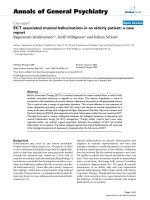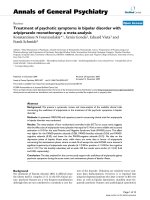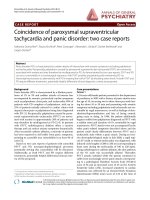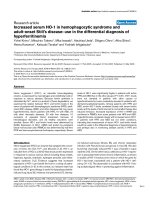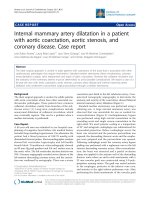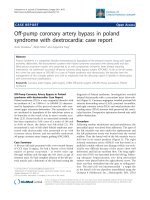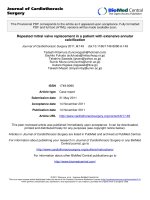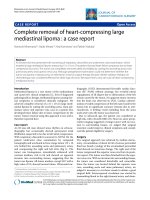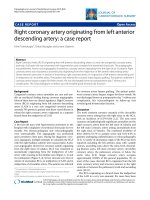Báo cáo y học: "Off-pump coronary artery bypass in poland syndrome with dextrocardia: case report" pdf
Bạn đang xem bản rút gọn của tài liệu. Xem và tải ngay bản đầy đủ của tài liệu tại đây (758.21 KB, 3 trang )
CASE REP O R T Open Access
Off-pump coronary artery bypass in poland
syndrome with dextrocardia: case report
Vivek Srivastava
1*
, Ranjit More
2
and Augustine Tang
1
Abstract
Poland Syndrome is a congenital disorder characterised by hypoplasia of the pectoral muscles along with upper
extremity deformities. We encountered a patient with Poland syndrome associated with dextrocardia and also
failed pectus excavatum repairs who presented to us with symptomatic ischaemic heart disease requiring
intervention. He underwent successful off-pump coronary artery bypass surgery (OPCABG). As far as we are aware,
this is the first case report of OPCABG in a case of Poland syndrome with dextrocardia. We describe here the
management of this complex patient and wish to emphasise that the off-pump option is feasible in dextrocardia
with some technical modifications.
Keywords: Coronary artery bypass graft surgery, CABG, Off-pump surgery, OPCAB, Pectus excavatum, Poland
Syndrome
Off-Pump Coronary Artery Bypass in Poland
syndrome with dextrocardia: Case Report
Poland syndrome (PS) is a rare congenital disorder with
an incidence of 1 in 7,000 to 1 in 100,000 [1] character-
ized by hypoplasia of the pectoral muscles with asso-
ciated upper extremity deformities. The anomalies in PS
are attributed to hypoplasia of the subclavian artery or
its branches as the result of an in-utero vascular acci-
dent [2,3]. Dextrocardia is an associated anomaly and
has been reported in 5.6% cases of a series of 144 and
in 9.6% of these, the defect was left-sided [2]. We
encounteredacaseofleftsidedPolandsyndromeasso-
ciated with dextrocardia who presented to us with
coronary artery disease and successfully underwent
off-pump coronary artery bypass grafting (OPCABG).
Case Summary
A 66-year-old male presented with a two-month history
ofCCSclassIIangina.Hehadahistoryoftwofailed
repairs of pectus excavatum - at twelve years age
through midline and through the left chest at age of
nineteen years. He had complete absence of the left pec-
toral muscle and a deformity of the left hand raising the
diagnosis of Poland syndrome. Investigations revealed
isolated dextrocardia with a concordant heart (si tus soli-
tus) (Figure 1). Coronary angiogram revealed proximal left
anterior descending artery (LAD), proximal circumflex,
mid right coronary artery (RCA) and ostial posterior des-
cending artery (PDA) stenoses with preserved left ventri-
cular function. Preoperative spirometry showed only mild
airflow obstruction.
Procedure
Following median sternotomy and pericardiotomy, the
pericardial space was freed from adhesions. The apex of
the left ventricle was seen under the xiphisternum and
the left pulmonary artery was located near the ventral
midline. Thus the lateral wall of the l eft ventricle was in
full view in its native position (Figure 2). The right
internal mammary artery (RIMA) was harvested as a
pedicled conduit without any damage (which was tech-
nically very difficult because of the severe chest wall
deformity) and had an excellent flow. The long saphe-
nous vein (SVG) was harvested from the left leg. Follow-
ing adequate heparinisation, two deep pericardial
sutures w ere placed below the right phrenic nerve. The
heart was then verticalised into the apex to ceiling posi-
tion. The mid-LAD was intramyocardial - a target site
in the distal LAD was therefore immobilised using the
Octopus 4 (Medtronic Inc., Minneapolis, MN, USA)
* Correspondence:
1
Department of Cardiothoracic Surgery, Lancashire Cardiac Centre, Victoria
Hospital, Blackpool, FY3 8NR, UK
Full list of author information is available at the end of the article
Srivastava et al. Journal of Cardiothoracic Surgery 2011, 6:75
/>© 2011 Srivastava et al; licensee BioMed Central Ltd. This is an Open Access artic le d istributed under the terms of the Creative
Commons Attribution License ( which permits unrestricted use, distribution, and
reproduction in any medium, pro vided th e origina l work is properly cited.
stabiliser. This was associated with a drop in the systolic
blood pressure and the cardiac index despite small
boluses of vasoconstrictor and inotrope. It was therefore
decided to use an intra-aortic balloon pump (IABP)
with subsequent hemodynamic stability. With the oper-
ating surgeon on the left side of the patient, the pedicled
RIMA was anastomosed to a distal LAD arteriotomy
with use of an intracoronary shunt. The surgeon then
moved from the left side to the right side of the patient
and inserted two left-sided deep pericardial sutures to
maximise exposure of the obtuse marginal (OM) target.
This was necessary because of the severe asymmetrical
sternal deformity f rom pectus excava tum. The diagonal
and then OM were grafted from the left side using SVG
as usual. Again the surgeon moved to the right side to
construct the PDA anastomosis using SVG. The proximal
anastomoses were then constructed. Following full prota-
mine reversal, the wound was closed as usual with steel
wires for the sternum and the patient transferred to ICU.
The IABP was removed on the 1
st
postoperative day and
the patient was discharged home on the 5
th
day after an
uneventful recovery.
Discussion
Ailiwadi et al [4] have previously reported coronary artery
bypass in a patient with Poland syndrome and d emon-
strated normal flow through the left internal mammary
artery (LIMA) before using it as a conduit. In a recent arti-
cle, Saad et al [5] reviewed coronary artery bypass in dex-
trocardia. They found 10 off-pump cases while 14 cases
used cardiopulmonary bypass. In 16 of the 24 cases, the
RIMA was grafted to the LAD. Surgery was performed
from the right side in 5 cases and from the left in 10. The
surgeon needed to switch sides in 3 cases. To our knowl-
edge, ours is the first report of OPCABG in a case of
Poland synd rome with dextrocardia and only the second
case report of coronary artery bypass in Poland syndrome.
Any concerns about an insufficient LIMA were addressed
by use of RIMA. Surgery was further facilitated by a
change in the surgeon’s position. We wish to emphasise
that OPCABG is a feasible option in patients with dextro-
cardia and adequate revascularisation can be achieved
with planning and certain technical modifications.
Declaration
Written informed consent was obtained from the patient
for publication of this case report and accompanying
images. A copy of the written consent is available for
review by the Editor-in-Chief of this journal.
Author details
1
Department of Cardiothoracic Surgery, Lancashire Cardiac Centre, Victoria
Hospital, Blackpool, FY3 8NR, UK.
2
Department of Cardiology, Lancashire
Cardiac Centre, Victoria Hospital, Blackpool, FY3 8NR, UK.
Authors’ contributions
VS was involved in the preparation of draft and finalisation of the
manuscript. RM advised regarding preparation of manuscript. AT was the
chief surgeon and responsible for finalisation of the manuscript.
All authors read and approved the final manuscript.
Competing interests
The authors declare that they have no competing interests.
Received: 13 March 2011 Accepted: 18 May 2011
Published: 18 May 2011
References
1. Fokin AA, Robicsek F: Poland’s syndrome revisited. Ann Thorac Surg 2002,
74:2218-2225.
2. Bavinck JN, Weaver DD: Subclavian artery supply disruption sequence:
hypothesis of a vascular etiology for Poland syndrome, Klippel-Feil, and
Mobius anomalies. Am J Med Genet 1986, 23:903-918.
3. Bouvet JP, Leveque D, Bernetieres F, Gros JJ: Vascular origin of Poland
syndrome? Eur J Pediatr 1978, 128:17-26.
Figure 1 CT scan showing dextrocardia with situs solitus.
(RIMA- Right Internal Mammary Artery).
Figure 2 Operative photograph demonstrating ma jor cardiac
mass under the right hemisternum. The Left Anterior Descending
Artery (LAD) is seen coursing from left to right. (RVOT - Right
Ventricular Outflow Tract).
Srivastava et al. Journal of Cardiothoracic Surgery 2011, 6:75
/>Page 2 of 3
4. Ailiwadi M, Arildsen RC, Greelish JP: Poland syndrome: a contraindication
to the use of the internal thoracic artery in coronary artery bypass
grafting? J Thorac Cardiovasc Surg 2005, 130:578-579.
5. Saad RA, Badr A, Goodwin AT, Dunning J: Should you stand on the left or
the right of a patient with dextrocardia who needs coronary surgery?
Interact Cardiovasc Thorac Surg 2009, 9:698-702.
doi:10.1186/1749-8090-6-75
Cite this article as: Srivastava et al.: Off-pump coronary artery bypass in
poland syndrome with dextrocardia: case report. Journal of
Cardiothoracic Surgery 2011 6:75.
Submit your next manuscript to BioMed Central
and take full advantage of:
• Convenient online submission
• Thorough peer review
• No space constraints or color figure charges
• Immediate publication on acceptance
• Inclusion in PubMed, CAS, Scopus and Google Scholar
• Research which is freely available for redistribution
Submit your manuscript at
www.biomedcentral.com/submit
Srivastava et al. Journal of Cardiothoracic Surgery 2011, 6:75
/>Page 3 of 3
